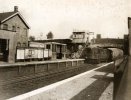I was just looking through some old railway photos with regards to the milk churn thread and noticed some photos have a white line along the platform edges, and some don't. One photo even shows a guy at track level repainting a platform edge white.
All these photos range from around 1950 to around the mid 1960's, unfortunately those that show the stations (Lancs BR LM region) unlike the photos of the trains are undated.
Was the painting of platform edges brought in gradually over time or from a certain year?
Was this a BR thing? or did it start with the big four pre BR?
And why white? maybe it was easier to see on a dark platform at night? We usually use red to denote danger but that's difficult to see on a poorly lit platform at night.
I have in my collection two photos of one particular station, one we know is 1952, it has the white line and it's dated, the other one isn't dated and doesn't show the white line and is pre 1952.
All these photos range from around 1950 to around the mid 1960's, unfortunately those that show the stations (Lancs BR LM region) unlike the photos of the trains are undated.
Was the painting of platform edges brought in gradually over time or from a certain year?
Was this a BR thing? or did it start with the big four pre BR?
And why white? maybe it was easier to see on a dark platform at night? We usually use red to denote danger but that's difficult to see on a poorly lit platform at night.
I have in my collection two photos of one particular station, one we know is 1952, it has the white line and it's dated, the other one isn't dated and doesn't show the white line and is pre 1952.




